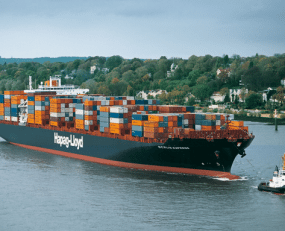
Where the last year has shown a significant drop in revenues and profits for global container shipping line Hapag Lloyd, its short to medium term plans signal a strategic plan to avoid such dips in the future. This, it appears is hoped to steady the ship from future storms and calms.
Barring a 0.5% y-o-y uptick in volumes over 2023 to 11.9m TEU, all financial figures were sharply down for Hapag Lloyd, as announced in its preliminary financial results for the full year. This comes as the company announced a dramatic split from its THE Alliance vessel sharing agreement (VSA) and a tie up with Maersk.
Perhaps unsurprising due to the state of the global sea freight industry with its well understood oversupply and lagging demand, Hapag Lloyd reported dramatic falls in revenues and profits. Where volumes were up marginally, the average price per TEU was down 54.7% y-o-y to US $1,500. This impacted the rest of the company’s results that included:
The full results will be published on 14 March – watch this space for further analysis. According to Transport Intelligence data, Hapag Lloyd is the 10th largest global logistics company in terms of revenue. With the majority of its income stemming from container liner services, it has been heavily exposed to the global sea freight downturn in 2023.
In Q3 it announced it was forming a new Terminals division ahead of the 2024 financial year that may go some way to insulating itself from future downturns. Its surprise announcement that it will cooperate with Maersk may further support Hapag Lloyd’s hopes to reduce the cyclicality of its earnings.
Gemini Cooperation with Maersk
In mid-January, Hapag Lloyd shocked and dismayed its partners in THE Alliance global vessel sharing agreement (VSA) by announcing a new tie up with second-largest global container liners, Maersk. This will begin operations in January 2025.
Hapag Lloyd’s current collaborators ONE, Yang Ming and HMM will be left in the lurch, and be unable to be an effective global alliance. Hapag Lloyd however has big plans for the Gemini Cooperation in which it will supply 40% of the capacity to Maersk’s 60%.
Maersk is also withdrawing from its alliance 2M at the end of 2024, and earlier in 2023 had announced it had no plans for a future VSA so this was a particular surprise for industry watchers.
Between the two Europe based shipping companies, they will have 290 vessels with a global capacity of 3.4m TEU. The Gemini Cooperation will aim at a 90% schedule reliability, far above the average 60% managed by most liners today.
Under the new VSA, the companies will operate a hub-and-spoke network with all but two global hubs owned and operated by either Maersk or Hapag Lloyd. This may well help drive business into Hapag Lloyd’s new Terminals division once fully operational in 2025.
Speaking of the new VSA, Hapag Lloyd CEO Habben Jansen said, “Teaming up with Maersk will help us boost the quality we deliver to customers.” Referring to hopes for better margins to be gained from the new VSA, Jansen continued, “Additionally we will benefit from efficiency gains in our operations.”
Both Maersk and Hapag Lloyd claim to be global leaders in decarbonising sea transport. Maersk aims to be net zero by 2040 and Hapag Lloyd, 2045. Both are rolling out alternatively fuelled ships in the short to medium term. Referring to this, Jansen said this will “Further accelerate the decarbonisation of our industry.”
Part of the planned improvements in schedule reliability is planned slow-steaming for longer legs on larger ships. This efficiency should significantly reduce the carbon intensity of the Gemini Cooperation’s operations while improving reliability by changing expectations on timings. Improved reliability should in turn boost revenues as shippers seeking more definite timings may abandon their current liners in favor of the new VSA.
Author: Richard Shrubb
Source: Ti Insights
Supply chain strategists can use GSCi – Ti’s online data platform – to identify opportunities for growth, support strategic decisions, help them stay abreast of industry trends and development, as well as understand future impacts on the industry.
Visit GSCI subscription to sign up today or contact Michael Clover for a free demonstration: [email protected] | +44 (0) 1666 519907